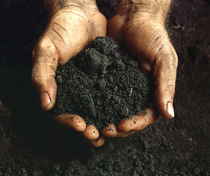Nevada State Soil
Orovada Series Soil

Classified as coarse-loamy, mixed, superactive, mesic Durinodic Xeric Haplocambids
Adopted in 2001.
The Orovada Series Soil was designated as Nevada's official state soil in 2001. Alfalfa for hay and seed, winter wheat, barley, and grasses for hay and pasture are the principal crops grown on these soils.
This soil is classified as coarse-loamy, mixed, superactive, mesic Durinodic Xeric Haplocambids, and is found in Northern and Central Nevada. Orovada soil grows most crops common to Nevada and is considered prime farmland because it contains volcanic ash that reduces the amount of water needed for irrigation.
Nevada State Soil: Orovada Series Soil

Orovada soils are extensive in northern Nevada, where they have an extent of more than 360,000 acres. They are common soils on semiarid rangeland with sagebrush-grass plant communities. Orovada soils are arable when irrigated and are considered prime farmland. Alfalfa for hay and seed, winter wheat and barley, and grass for hay and pasture are the principal crops grown on these soils.
Orovada soils are well drained and formed in alluvium derived from mixed rock sources and in loess and volcanic ash. These soils typically occur in the Great Basin section of the Basin and Range physiographic province. The mean annual precipitation is about 8 inches, and the mean annual temperature is about 47 degrees F.
Orovada Soil Profile
Surface layer: light brownish gray sandy loam
Subsurface layer: light brownish gray loam
Subsoil: light gray fine sandy loam
Substratum - upper: light brownish gray very fine sandy
loam with carbonates
Substratum - lower: pale brown silt loam with carbonates
OROVADA SERIES
The Orovada series consists of very deep, well drained soils that formed in loess high in volcanic ash over alluvium derived from mixed rocks. Orovada soils are on fan skirts, fan remnants, fan aprons, inset fans, calderas, and draws. Slopes are 0 to 15 percent. The mean annual precipitation is about 230 mm and the mean annual temperature is about 8 degrees C.
TAXONOMIC CLASS: Coarse-loamy, mixed, superactive, mesic Durinodic Xeric Haplocambids
SERIES ESTABLISHED: Nye County (Big Smoky Valley Area), Nevada, 1972.
Nevada Law
The law designating the soil series known as Orovada series as the official Nevada state soil is found in the Nevada Revised Statutes, Title 19, Chapter 235, Section 235.115.
TITLE 19- MISCELLANEOUS MATTERS RELATED TO GOVERNMENT AND PUBLIC AFFAIRS
CHAPTER 235 - STATE EMBLEMS; GIFTS AND ENDOWMENTS
MISCELLANEOUS STATE EMBLEMS
NRS 235.115 State soil. The soil series known as Orovada series, classified as coarse-loamy, mixed, superactive, mesic Durinodic Xeric Haplocambids,
is hereby designated as the official state soil of the State of Nevada. (Added to NRS by 2001, 392)







